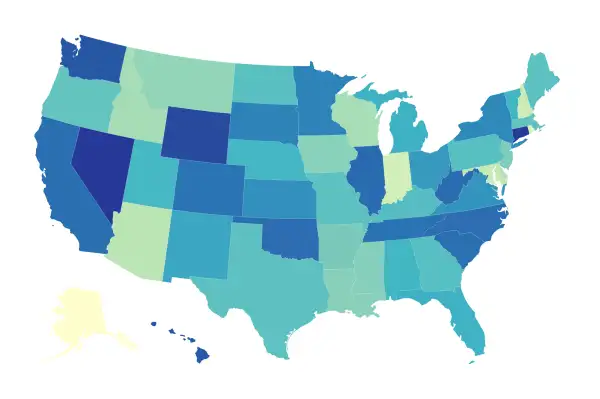This Map Shows Where U.S. Workers Are Getting the Biggest Pay Raises

American workers are finally seeing their wages rise. But how fast depends a lot on where you live.
Last year was a good one for the U.S. job market. By December, unemployment was down to 3.9% — the lowest December reading since 2000 — and the U.S. had added 2.6 million jobs, marking the first time in almost two decades that a calendar year saw more than 100,000 new jobs added every month.
Average hourly wages went up too, according to the Bureau of Labor Statistics. On average, non-government employees were making $27.68 at the end of last year, which was up 4% from the previous December. In fact, not a single state saw a decrease for 2018.
Workers in the District of Columbia started 2018 as the highest-paid in the nation, with average hourly earnings of $42. During 2018, their wages climbed 7.7% — faster than any U.S. state — to $45. But D.C. wasn't the only area experiencing a big uptick.
The U.S. state with the fastest wage growth was Nevada, where hourly wages rose 7.5% to $24.41 from $22.71. Nevada's recent success in employment numbers, including wage growth, were thanks to a job market that has been expanding and diversifying beyond tourism after it was hit particularly hard during the Great Recession. Average wages in Nevada remain below the $26.58 national average, so there is plenty of room to grow.
A handful of other states exceeded the 6% wage growth marker too. Wyoming’s economy benefited from an increase in visitors to its national parks and a good year for its mining sector. And in Washington, two tech giant tenants, Microsoft and Amazon, helped bring home a 5.7% bump to the GDP — the highest in the country last year. Almost every major industrial sector in Washington added jobs, but not as much as the information services and retail sectors, which have helping the state move up the ranks for years now.
But these states were in the minority in terms of how fast they grew. Most states — about three-fourths of them — increased by 3% to 6%, year-over year.
North Carolina’s growing tech industry, centered around the Raleigh-Durham-Chapel Hill triangle, is helping wages climb. And in West Virginia, where economic growth has been relatively slow for the most part, a rebound in natural gas prices last year made the average hourly wage one of the fastest-growing in the nation.
Of course, don’t go flocking to these states just yet: A bigger percent change from one state to the next doesn’t necessarily translate to a higher take-home income. Wages barely budged in Maryland and Alaska. But average pay in both states was already high, about $30 an hour, placing them in the 81st percentile among U.S. states by the end of 2018.
Here’s a year-over-year breakdown of every state’s average hourly wage:
